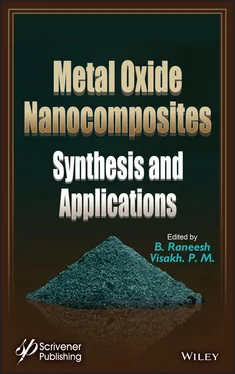Metal Oxide Nanocomposites
Здесь есть возможность читать онлайн «Metal Oxide Nanocomposites» — ознакомительный отрывок электронной книги совершенно бесплатно, а после прочтения отрывка купить полную версию. В некоторых случаях можно слушать аудио, скачать через торрент в формате fb2 и присутствует краткое содержание. Жанр: unrecognised, на английском языке. Описание произведения, (предисловие) а так же отзывы посетителей доступны на портале библиотеки ЛибКат.
- Название:Metal Oxide Nanocomposites
- Автор:
- Жанр:
- Год:неизвестен
- ISBN:нет данных
- Рейтинг книги:5 / 5. Голосов: 1
-
Избранное:Добавить в избранное
- Отзывы:
-
Ваша оценка:
- 100
- 1
- 2
- 3
- 4
- 5
Metal Oxide Nanocomposites: краткое содержание, описание и аннотация
Предлагаем к чтению аннотацию, описание, краткое содержание или предисловие (зависит от того, что написал сам автор книги «Metal Oxide Nanocomposites»). Если вы не нашли необходимую информацию о книге — напишите в комментариях, мы постараемся отыскать её.
Metal Oxide Nanocomposites — читать онлайн ознакомительный отрывок
Ниже представлен текст книги, разбитый по страницам. Система сохранения места последней прочитанной страницы, позволяет с удобством читать онлайн бесплатно книгу «Metal Oxide Nanocomposites», без необходимости каждый раз заново искать на чём Вы остановились. Поставьте закладку, и сможете в любой момент перейти на страницу, на которой закончили чтение.
Интервал:
Закладка:
Due to the limitations and high costs associated to large-scale production, the arc discharge and laser ablation techniques are not promising. Often, as produced CNTs contain various degrees of impurities such as fragments of wrapped-up graphene sheets, soot, amorphous C, fullerene, and metal catalyst particles [43], thus purification is needed to purify CNTs because these impurities deteriorate the desired and promising properties and performance of CNTs [44]. Given that gas phase techniques such as CVD method can produce large quantities of CNTs with fewer impurities and particularly, they are superior for in situ assembly of metal oxide nanoparticles (NPs) with CNTs, the gas phase techniques hold the greatest potential for scaling-up manufacturing of CNT-based NCs. Alternatively, derivatization of CNTs with other families of organic interlinker molecules particularly biomolecules (e.g., DNA and biotin streptavidin) offer another promising and versatile route in the assembly of CNTs and metal oxide NPs [45, 46]. The advantage of covalent approach is that various well-defined, structurally tunable interlinkers excel in hybridizing metal oxide NPs and CNTs, projecting the flexibility and versatility of this approach. However, as mentioned above, the electronic and mechanical properties of CNTs would be disrupted because sp2-hybridized C atoms are converted to sp3-hybridized analogues after functionalization. Hydrophobic interactions between long chains of aliphatic compounds and CNTs’ hydrophobic surfaces can be used to assemble metal oxide NPs and CNTs. For instances, phosphonic acid- and alkoxysilane-functionalized MWCNTs were templated to hybridize TiO 2and SiO 2NPs; and the resulting NCs show great promise in building blocks for sensors, nanoscale switches, and other nanodevices [47]. Surfactants such as sodium dodecyl sulfate (SDS) and Triton X are also powerful binding motifs for connecting metal oxide NPs (e.g., Pd and ZnO) and CNTs [48, 49]. Particularly, a combination of hydrophobic interaction and hydrogen bonding improves the assembly of CNTs and metal oxide NPs. Au NPs (2–5 nm diameter) covered by a mixed-monolayer of decanethiol and mercaptoundecanoic acid were adjoined strongly with acid-treated CNTs containing carboxylic groups [50]. Both hydrophobic interactions arising from alkyl chains and hydrogen bonding due to carboxylic groups contributed to the formation of stable NCs. The major advantage of hydrophobic assembly is that, in some cases, simple and non-specific physical mixing is suffice to obtain desirable CMNCs [51]. CNTs can be modified to capture either negative or positive surface charges through polyelectrolyte or polymer-wrapping, thereby connecting positively or negatively charged NPs via electrostatically attractive interaction. For example, chemically oxidized CNTs were capped with a thin film of cationic poly(diallyldimethylammonium) (PDDA), serving as the template for anchoring the negatively charged Au NPs (10 nm) [52].
Attributed to the robustness of regulation of nucleation and growth processes, electrochemistry is demonstrated as a powerful way for depositing metal NPs onto CNTs directly, especially for noble metals such as Pd [53, 54], Pt [55], Au, Ag, and bimetallic Pt–Co [56] with potential implications in heterogeneous catalysis, electrocatalysis, biosensors, and fuel cells. Typically, metal NPs can attach onto CNTs’ surface via reduction of metal salts (e.g., AuCl −, PtCl62 −, and PdCl42 −), with the aid of reducing agents such as H 2[57], NaBH [58], citric acid [59], or ethylene glycol [60]. The size of the resulting metal NPs and their assembly onto CNTs’ surface can be tailored by adjusting reactant concentration, reaction time and temperature, and nucleation potential and voltage, or by introducing surfactants [61]. An earlier review has addressed potential environmental applications of C-based NMs including CNTs and their composites [62]. Deposition of transition metals (e.g., Au, Ni, Pd, Pt, and Ti) has been achieved on perfect and defective MWCNTs via thermal evaporation of different amounts of metals onto the substrates [63]. Other metal and metallic NMs have also been decorated onto CNTs’ surface including Ag, Cu, and PdO [64]. Confinement of other NPs inside CNTs has been reported including Se [65], Co [66, 67], Pd [68], and magnetite [69]. A more comprehensive review has showcased dozens of inorganic compounds used in CMNCs including synthesis methods, and tested and potential applications. Another review has provided a thorough CNT characterization summary and discussion of adsorption mechanisms of organic contaminants by CNTs as well as the statistical adsorption model development efforts. Other reviews have demonstrated the importance of surface modification of CNTs for removal of heavy metals and organics from industry wastes [69–71]. Specific sensors can be developed for detecting specific analytes. A novel nitrite sensor has been developed by electropolymerization of alizarin red on the surface of glassy C electrode modified with MWCNT–Fe 3O 4composite nanofilm [72].
1.4 Metal Oxide-Based Nanocomposites Application Towards Photocatalysis
Photocatalysis has long been studied and is expected to make a great contribution to both environmental treatment (emission cleaning and water purification) and renewable energy. Over the past few decades, the number of applications based on photocatalysis increased sharply; while a wide range of materials systems have been developed [73]. Photocatalytic H 2production from water is one of the most promising ways to realize a hydrogen economy for three reasons. (1) This technology is based on photon (or solar) energy, which is a clean, permanent source of energy, and mainly water, which is a renewable resource; (2) it is an environmental safe technology without undesirable by-products and pollutants; and (3) the photochemical conversion of solar energy into a storable form of energy, i.e . hydrogen allows to deal with the intermittent character and seasonal variation of the solar influx. Nano science and nanotechnology have boosted the modification of existing photocatalysts and the discovery and development of new candidate materials [74]. The rapidly increasing number of scientific publications constitutes clear bibliographical evidence for the significance of this hot topic. The valence holes are good oxidants and the conduction electrons are reductants. In most cases, the organic compounds are degraded by oxidation reaction involving photogenerated holes. Since 1972, scientists discovered the photocatalytic splitting of water on the illuminated single crystal TiO 2electrodes [75], the photocatalysis as a research area is of significant interest and photocatalytic processes have been extensively studied.
The adoption of TiO 2photoanode as well as a Pt counter electrode soaked in an aqueous electrolytic solution made it possible for the water to be incised, which was caused by UV light. This was conducted by Honda and Fujishima in 1972. It has been issued that the charge clipping and photocatalytic performance can be improved by combination of semiconductor with a wide band gap like SnO 2with TiO 2[76, 77]. There is an effective of promoting the photocatalytic performance of visible light, namely TiO 2matrix is inserted with the combination of metal ions. The principle of this approach is through blocked charge carrier recombination [78]. The insertion of the metal ion promotes the shape of Ti 3+ions, thus improving the photocatalytic performance. Transforming the TiO 2through incorporation of two or more than two dopants is issued, which makes great combination influence. On the contrary, the undoped TiO 2or the TiO 2with one ion incorporated is less effective [79, 80]. Surface spots, oxygen vacancies and polar planes contribute the difference in photocatalytic performance of ZnO. With solvothermal technique, Xu et al . synthesized carious forms of ZnO and adopted them as photocatalyst to degrade the phenol [81].
Читать дальшеИнтервал:
Закладка:
Похожие книги на «Metal Oxide Nanocomposites»
Представляем Вашему вниманию похожие книги на «Metal Oxide Nanocomposites» списком для выбора. Мы отобрали схожую по названию и смыслу литературу в надежде предоставить читателям больше вариантов отыскать новые, интересные, ещё непрочитанные произведения.
Обсуждение, отзывы о книге «Metal Oxide Nanocomposites» и просто собственные мнения читателей. Оставьте ваши комментарии, напишите, что Вы думаете о произведении, его смысле или главных героях. Укажите что конкретно понравилось, а что нет, и почему Вы так считаете.












